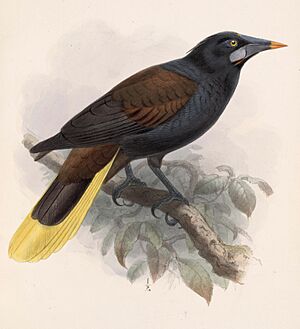Black oropendola facts for kids
Quick facts for kids Black oropendola |
|
|---|---|
 |
|
| Conservation status | |
| Scientific classification | |
| Genus: |
Psarocolius
|
| Species: |
guatimozinus
|
 |
|
The black oropendola (Psarocolius guatimozinus) is a cool bird from the Icteridae family. This family includes many New World blackbirds. You can find this bird living in the forests of Colombia and Panama. It loves warm, wet lowland forests, which are its natural habitat.
Contents
What Does the Black Oropendola Look Like?
Male black oropendolas are about 46 centimeters (18 inches) long. Females are a bit smaller, around 39.5 centimeters (15.5 inches). Both males and females look very similar. They are mostly black. Their back, rump, some wing feathers, and the area around their tail are a dark chestnut color.
They have a cool bluish patch of bare skin on their cheek. This patch has a pink edge at the bottom. Their beak is black with a bright orange tip.
Where Does the Black Oropendola Live?
The black oropendola lives only in the humid forests of northwestern South America. Its home includes northwestern Colombia, reaching as far east as the Magdalena River. It also lives in the very southeastern part of Panama. This whole area covers about 108,000 square kilometers (41,700 square miles). These birds usually live in areas up to about 800 meters (2,600 feet) high.
How Does the Black Oropendola Live?
Scientists haven't studied the black oropendola's habits a lot yet. But they think it eats insects, small animals, and fruit. It often climbs high in the treetops. It might even sip nectar from flowers.
These birds nest together in groups, like a bird colony. Up to twenty birds might build their nests in the same tree! Their eggs are pale pink with a few reddish-brown spots. It's likely that one male black oropendola mates with many females. In Panama, they breed in February. In Colombia, their breeding season is from April to June.
Is the Black Oropendola in Danger?
The black oropendola lives across a large area. People say it is quite common. Its numbers seem to be steady, and no big threats have been found. Because of this, the International Union for Conservation of Nature says its conservation status is "least concern". This means it's not currently in danger of disappearing.


